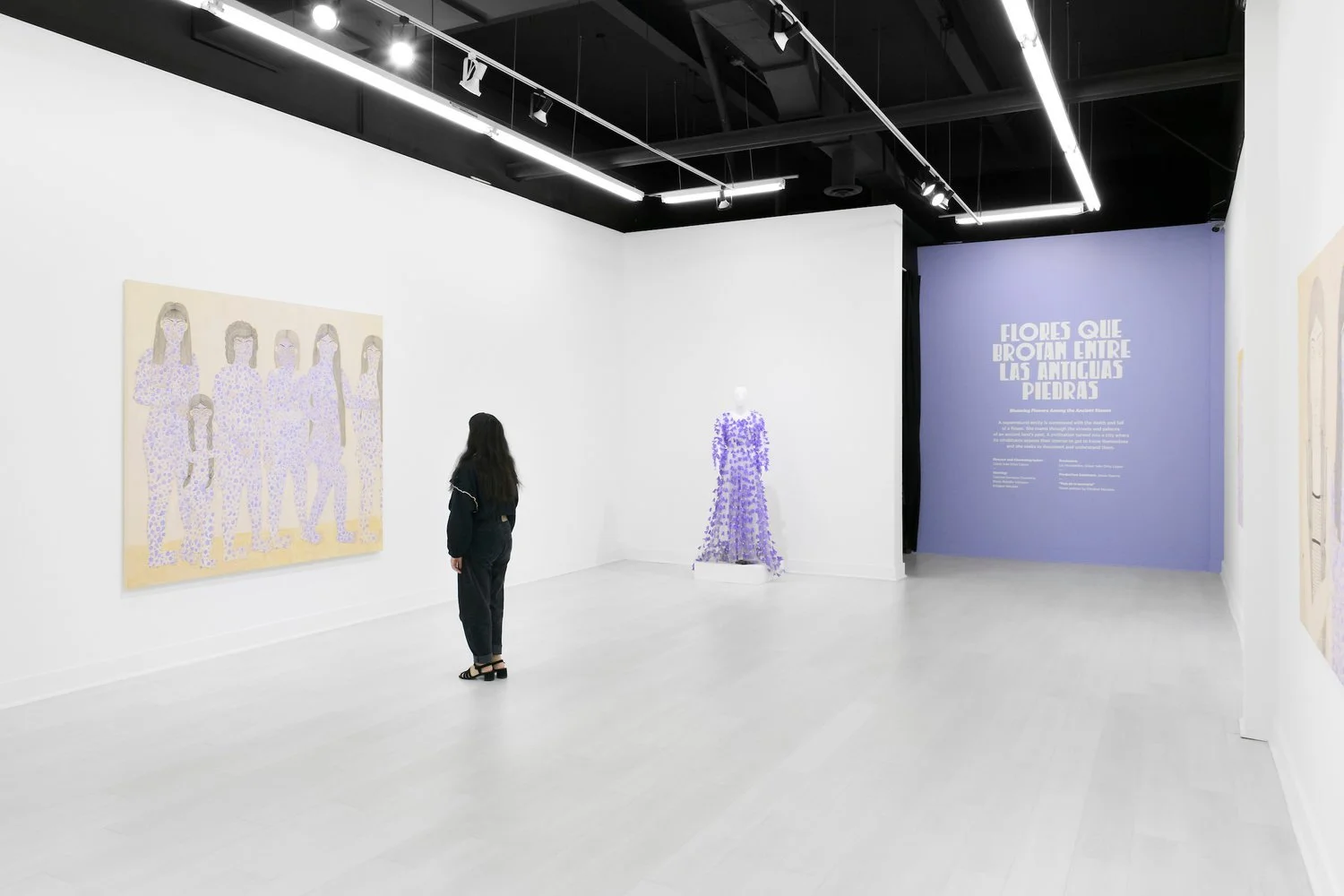The Truth of the Jacaranda
“Donde las flores moradas lloran (Where the Purple Flowers Cry)”
a solo exhibition by
Liz Hernández
at pt. 2 Gallery, Oakland, California
What are you afraid of? What makes you sad?
These questions are posed to residents of Mexico City’s Zocalo district in the short film Flores que brotan entre las antiguas piedras ((Blooming Flowers Among the Ancient Stones) bear recurring answers of insecurity, earthquakes, and the inability to be with and protect loved ones. The roughly twenty-minute film follows a nameless protagonist in search of herself, or perhaps her soul.
Clad in a breezy dress of purple jacaranda flowers, we follow the protagonist on a journey across the city, momentarily aware of her mythological status as she fades in and out of visibility. When asked by a social worker for her name, she cannot give one. The social worker proclaims that without one, the system will not work.
Yet as the rest of the exhibition demonstrates, the system does not work even with a name. Hernández’s exhibition is dedicated to the lost women of Mexico, who vanished in rushes of violence, kidnapping, and inadequate response and recovery efforts.
Installation view: Liz Hernández, Where the Purple Flowers Cry. Photo courtesy the artist and pt. 2 Gallery
The depth of this violence, the inaction of authorities, and victim-blaming is spelled out in Breve informe de los hallazgos de Camohpalxochichoquiztlan (Brief report of the findings of Camohpalxochichoquiztlan), a research-based piece made in collaboration with Estefanía Arista. Hernández’s mythology of the village of Camohpalxochichoquiztlan, where Jacarandas bloom and women disappear without justice, tells of spirits that are half-woman, half cloud of purple flowers that offer protection and the gift of closure.
The resulting loss is most palpable in two embroidered works. Recalling indigenous Mexican embroidery work and Hernández’s allover composition style, the vignettes across these pieces tell stories of love and loss. A family sits around the dinner table wishing for the figure of their mother, depicted as a black shadow. A daughter appears the same way in a family photograph. A woman in bed thinks “te veo en suenos y me dices donde estas (i see you in dreams and i say where are you). A poster reads “hasta encontrarte (until you are found).
The weight of these messages is emphasized in the playful, colloquial nature of the medium. Rendered in pleasant colors with simplified iconography, one expects the medium to tell a gentle mythology. It is within this contradiction that Hernández’s work strikes so suddenly, by reappropriating things of beauty and encouraging the viewer to see the truth beneath the fragile aesthetics.
The women clad in jacaranda flowers in Hernández’s paintings and sculptures tell a similar tale. The six women in Que todo el mundo se entere: ahí vienen las Jacarandas (Let everyone know: here come the Jacarandas) do not wear jacarandas for fashion, they do because it is all they have left. Left between the material world and that of the spirit, the grace and poise of these women seek preservation and healing. The report reads: “They are equivalent to strength, defiance, revolution. In the challenge of their silence, they are not afraid of being seen.” The paper mache sculpture Un recuerdo del Camohpalxochitepetl (A souvenir of the Camohpalxochitepetl hill) portrays a group of women clad in jacaranda flowers defiantly in repose, content smiles plastered on their faces as they drink and smoke. While justice may not be a formidable hope, the jacarandas serve a greater truth, delivering closure to those who grieve, and to those who persevere.
